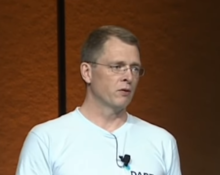Lars Bak | |
|---|---|
 Computer programmer Lars Bak | |
| Born | 1965[1] |
| Nationality | Danish |
| Occupation | Computer programmer |
| Years active | 1988–present |
| Known for | JavaScript expert, Virtual machine innovator |
| Awards | Senior Dahl–Nygaard Prize |
Lars Bak (born 1965)[1] is a Danish computer programmer. He is known as a JavaScript expert and for his work on virtual machines. He formerly worked for Google, having contributed to the Chrome web browser as the lead developer of the V8 JavaScript engine.
Professional life
[edit]Bak studied at Aarhus University in Denmark, receiving an MS degree in computer science in 1988 after which he became active in designing and implementing object-oriented virtual machines. He has been awarded the 2018 Senior Dahl–Nygaard Prize.[2]
Virtual machines
[edit]After participating in the design and implementation of the BETA Mjølner System, in 1991 he joined the research group for the programming language Self at Sun Microsystems Laboratories in Palo Alto, California. During his time there, he developed a programming environment for Self, and added several enhancements to the virtual machine.
In 1994, he joined LongView Technologies LLC, where he designed and implemented high performance virtual machines for both Smalltalk and Java. After Sun Microsystems acquired LongView in 1997, Bak became engineering manager and technical lead in the HotSpot team at Sun's Java Software Division where he developed a high-performance Java virtual machine.[3][4]
In 2002, after returning to Aarhus, Denmark, Bak founded OOVM, a company which developed software for mobile phones. In 2004, he sold it to a Swiss company, Esmertec.[5]
In 2006, Bak joined Google to work on the Chrome browser. He did not return to the United States, preferring to work in Denmark where his daughters were also receiving their education.[1] With a team of 12 engineers, Bak coordinated the development of the V8 JavaScript interpreter for Chrome, named after the V8 engine.[6]
Bak co-developed the Dart programming language presented at the 2011 Goto conference in Aarhus, Denmark.[7]
In 2017, Bak left Google and soon afterward co-founded[dubious – discuss] a startup with Kasper Lund called Toit, which is building a new programming language called Toit and a platform for Internet of things systems.[8][9]
Patents
[edit]Bak holds 18 U.S. Patents for software, in the field of virtual machine programming.[10] In 2010, after Oracle bought Sun and with Lars Bak working for Google, Oracle sued Google for infringing on several software patents and amongst them was the "Interpreting Functions Utilizing a Hybrid of Virtual and Native Machine Instructions" patent[11] filed by Lars Bak et al.
References
[edit]- ^ a b c Schenker, Jennifer L. (12 November 2008). "Google's Chrome: The Danish Magic Inside". Businessweek. Archived from the original on 21 October 2012. Retrieved 6 December 2013.
- ^ "The AITO Dahl-Nygaard Prize Winners for 2018". Association Internationale pour les Technologies Objets. Retrieved 7 January 2018.
- ^ Lars Bak, Biography, from JAOO.dk. Retrieved 29 March 2009.
- ^ Guest Lecture by Lars Bak: A New Approach to Developing Robust Embedded Software. Tampere University of Technology. Retrieved 29 March 2009.
- ^ The genius behind Google’s web browser. From FT.com. Retrieved 29 March 2009.
- ^ "V8: an open source JavaScript engine". YouTube. Google. Retrieved 15 March 2024.
- ^ "Presentations -> Opening Keynote: Dart, a new programming language for structured web programming". Gotocon.com. Retrieved 8 October 2013.
- ^ "Aarhus-eksperter fra Chromes Javascript-motor skaber IoT-sprog og virtuel maskine". Version2 (in Danish). 3 July 2018. Retrieved 27 July 2018.
- ^ Lund, Kasper (24 February 2019). "Leaving Google for a couple of devices". Toit Blog. Retrieved 25 June 2021.
- ^ Google's Chrome: The Danish Magic Inside. BusinessWeek. Retrieved 29 March 2009.
- ^ "Patent US6910205 - Interpreting functions utilizing a hybrid of virtual and native machine instructions". Google Patents. Retrieved 15 April 2020.